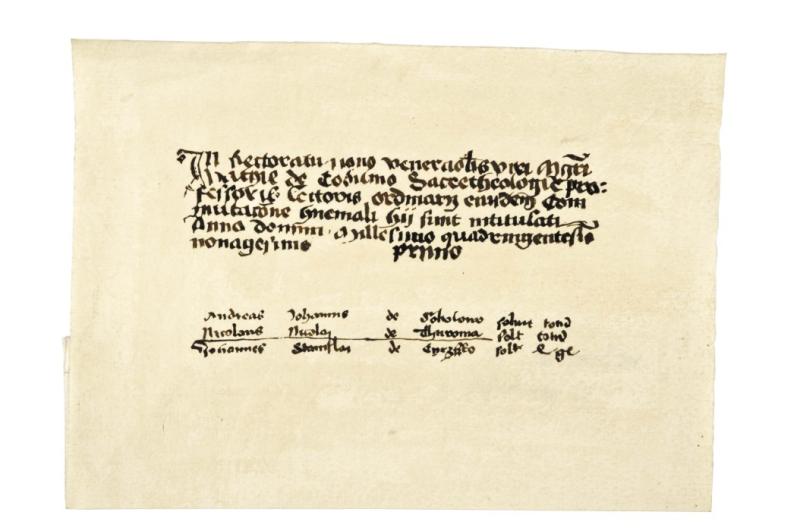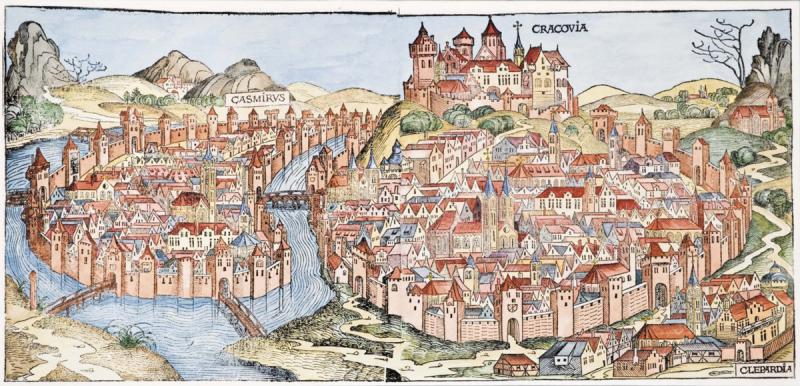Financially supported by their uncle, Lucas Watzenrode, Nicolaus Copernicus and his elder brother Andreas enrolled at the Kraków University Faculty of Liberal Arts in the autumn of 1491.
Kraków University in the late 15th c.
The choice of Kraków University was far from coincidental. Established in 1364 and once more in 1400, it ranked among the most prestigious in Europe attracting students from the whole continent, though especially from neighbouring countries. The latter group made up ca 50% of the total student population drawn there by the wonderful atmosphere of the economically prosperous and intellectually vibrant city which, with a population of 20,000, was also the seat of the royal court and a printing and publishing centre. The university itself, on the other hand, according to Hartmann Schedel’s World Chronicle (1493) was famous not only for its high level of instruction in the Liberal Arts (rhetoric, poetics, philosophy and physics) but even more so in mathematics and astronomy.
As a former student (1463–4), Lucas Watzenrode was well acquainted with its good reputation. At that time, the university had two highly-renowned departments which furthered the advancement of astronomic sciences: the first of Mathematics and Astronomy founded by Jan Stobner in 1405; the second of Astrology by Marcin Król of Żurawica in 1453. Astrology was then regarded as the crown of theoretical astronomy, hence its name, ‘practical astronomy’, and it also included medical science. The functioning of both contributed to the forming of an entire school of astronomy distinguishing Kraków from other European universities. By enrolling at the Jagellonian University, 18-year-old Copernicus could be assured that nowhere else would have given him a more comprehensive education in the field of astronomy.
Copernicus as a Kraków student
Copernicus was a conscientious student. The course of study he had selected gave him a profound knowledge of logic and philosophy and he read not only works by Aristotle and his commentators, but also Heraclitus of Ephesus, Democritus, Epicurus, Plato (in neo-platonic versions written by Marsilio Ficino and Cicero), Plutarch, Cicero and the Pythagoreans e.g. Eudoxus of Cnidus and Philolaus of Croton. As he admitted in the foreword to his book, addressed to Pope Paul III, it had been his studies of ancient philosophy that inspired Copernicus to take interest in the Earth’s orbit. He therefore attended the ‘higher’ classes in mathematics (arithmetic, geometry, geometric optics, cosmography, theoretical astronomy) required for the master’s examination. He then made an interesting collection of notes from lectures attended which he later had bound together with other books bought in Kraków. This notebook is mentioned in specialist literature as the Uppsala Raptularium.
Only a few of the names of Copernicus’ professors are known, among which the most noteworthy were Bartolomeus of Lipnica (d. 1538) who gave lectures on Euclid’s Elements, Michael Vratislaviensis (Michał Falkener, d. 1534) and, first and foremost, Albert of Brudzewo (Wojciech Brudzewski) who explained the difficult Tabulae resolutae, the summit of contemporary knowledge of astronomy. Copernicus was also introduced to the Kalendarium of Regiomontanus (Johannes Müller von Königsberg 1436-76), rarely presented in Kraków (but commented on by Marcin Biem of Olkusz – d. 1540), and attended lectures given by Jan of Głogów (Johann von Glogau, d. 1507) who had determined the exact co-ordinates of Kraków. He could not possibly have missed the private lectures offered by the latter in 1494, at which the scholar presented the new structure of the world (Geografia) after Columbus’s discovery of the New World. Presumably, Copernicus also attended those given by Albert of Brudzewo and he broadened his knowledge through individual study, reading the books he had purchased, and disputing with befriended humanist scholars including Laurentius Corvinus (Laurentius Rabe) from Silesia and the future cartographer Bernard Wapowski.
Aware of the defectiveness of Ptolemy’s system, the inaccuracy of the astronomical tables used and of the limited knowledge of astronomy among his contemporaries, Copernicus felt a great need for astronomical observations which, in his opinion, constituted rational verification of his theoretical studies. He must have seen the astronomical instruments donated by Marcin Bylica of Olkusz to the university and displayed on 14 October 1494 in Kraków, and this was where he learnt how to handle them and make scientific observations. Copernicus’ disciple, Georg Joachim Rheticus, mentions in his memoirs that while at Bologna University his master "was not so much a student as an assistant and witness to the astronomical observations" made by the eminent Italian astronomer Domenico Maria Novara. In 1542 Albert Caprinus of Bukowo remarked "…our university (Kraków) provided him (Copernicus) with the foundations of his future mathematical studies, which he has never denied; on the contrary, he has confessed that he owes everything he has achieved to the Academy".
During his studies at Kraków University Copernicus must have realized that the Ptolemaic system of the universe was faulty and needed to be improved. He must also have felt the need for a new approach to the astronomical sciences and therefore intentionally did not sit his master’s examination in Kraków and happily left for Bologna in the autumn of 1496 to continue his astronomical research while reading law at the same time.
While in Kraków, young Copernicus must have taken part in all kinds of official events that allowed him to do other things apart from studying. He must at least have seen the Polish kings and their advisors – even if from some distance. On 11 July 1492 he could have witnessed the stately funeral celebrations of King Casimir Jagellon (Kazimierz Jagiellończyk) buried in a beautiful vault in Wawel Cathedral made by Veit Stoss, and must have witnessed the coronation ceremony of the new Polish King, John I Albert (Jan Olbracht), on 23 September 1492.
 English (United Kingdom)
English (United Kingdom)  Polski (PL)
Polski (PL) 







